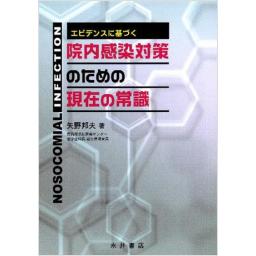5) Maki DG, Zilz MA, Alvarado CJ:Evaluation of the antibacterial efficacy of fouragents for handwashing. Current chemotherapy and infectious disease proceedings of the 11th International Congress on Chemotherapy and the 19th ICACC, Nelson JC, Grassi C (eds), American Society for Microbiology, Washington DC, 1979.
6) McBride ME:Microbial flora of in-use soap products. Appl Environ Microbiol 48:338-341, 1984.
7) Kabara JJ, Brady MB:Contamination of bar soaps under"in use"condition. J Environ Pathol Toxicol Oncol 5:1-14, 1984.
15) Larson EL, APIC Guidelines Committee:APIC guideline for handwashing and hand antisepsis in health care settings. Am J Infect Control 23:251-269, 1995.
16) Maki DG, McCormick RD, Zilz MA, et al:An MRSA outbreak in a SICU during universal precaution;new epidemiology for nosocomial MRSA;downside for universal precautions[Abstract 473]. Program and abstracts of the 30th Interscience Conference on Antimicrobial Agents and Chemotherapy, American Society for Microbiology, Washington DC, 1990.
18) Selwyn S:Microbiology and ecology of human skin. Practitioner 224:1059-1062, 1980.
27) Walter CW, Kundsin RB, Shilkret MA, et al:Spread of Staphylococci to the environment. Antibiotics Annual 952-957, 1959.
28) Boyce JM, Opal SM, Chow JW, et al:Outbreak of multidrug-resistant Enterococcus faecium with transferable van B class vancomycin resistance. J Clin Microbiol 32:1148-1153, 1994.
32) PottingerJ, Burns S, Manske C:Bacteriai carriage by artificial versus natural nails. Am J Infect Control 17:340-344, 1989.
36) Passaro DJ, Waring L, Armstrong R, et al:Postoperative Serratia marcescens wound infections traced to an out-of-hospital source. J Infect Dis 175:992-995, 1997.
45) Hayes RA, Trick WE, Vernon MO, et al:Ring use as a risk factor (RF) for hand colonization in a surgical intensive care unit (SICU) [Abstract K-1333]. Program and abstracts of the 41st Interscience Conference on Antimicrobial Agents and Chemotherapy, American Society for Microbiology, Washington DC, 2001.
46) Rotter M:Hand washing and hand disinfection[Chapter 87]. Hospital epidemiology and infection control, 2nd ed, Mayhall CG (ed), Lippincott Williams & Wilkins, Philadelphia, 1999.
50) Larson EL, Morton HE:Alcohols[Chapter 11]. Disinfection, sterilization and preservation, 4th ed, Block SS (ed), Lea and Febiger, Philadelphia, 1991.
51) Denton GW:Chlorhexidine[Chapter 16]. Disinfection, sterilization and reservation, 4th ed, Block SS (ed), Lea and Febiger, Philadelphia, 1991.
52) Gershenfeld L:Povidone-iodine as a sporicide. Am J Pharm 134:79-81, 1962.
53) Russell AD:Chemical sporicidal and sporostatic agents[Chapter 22]. Disinfection, sterilization and preservation, 4th ed, Block SS (ed), Lea and Febiger, Philadelphia, 1991.
55) Galle PC, Homesley HD, Rhyne AL:Reassessment of the surgical scrub. Surg Gynecol Obstet 147:215-218, 1978.
56) Dineen P:An evaluation of the duration of the surgical scrub. Surg Gynecol Obstet 129:1181-1184, 1969.
57) O:Farrell DA, Kenny G, O:Sullivan M, et al:Evaluation of the optimal hand-scrub duration prior to total hiparthroplasty. J Hosp Infect 26:93-98, 1994.
60) Pereira LJ, Lee GM, Wade KJ:The effect of surgical handwashing routines on the microbial counts of operating room nurses. Am J Infect Control 18:354-364, 1990.
61) O:Shaughnessy M, O'Malley VP, Corbett G, et al:Optimum duration of surgical scrub-time[Short note]. Br J Surg 78:685-686, 1991.
65) Dineen P:The use of a polyurethane sponge in surgical scrubbing. Surg Gynecol Obstet 123:595-598, 1966.
66) Bornside GH, Crowder VH Jr, Cohn l Jr:A bacteriological evaluation of surgical scrubbing with disposable iodophor-soap impregnated polyurethane scrub sponges. Surgery 64:743-751, 1968.
67) McBride ME, Duncan WC, Knox JM:An evaluation of surgical scrub brushes. Surg Gynecol Obstet 137:934-936, 1973.
69) Dewar NE, Gravens DL:Effectiveness of septisol antiseptic foam as a surgical scrub agent. Appl Microbiol 26:544-549, 1973.
